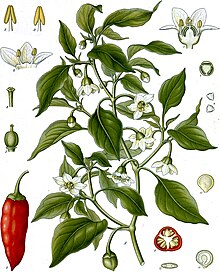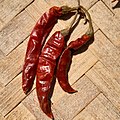bio.wikisort.org - Plant
Capsicum annuum is a species of the plant genus Capsicum native to southern North America, the Caribbean, and northern South America.[2][5] This species is the most common and extensively cultivated of the five domesticated capsicums. The species encompasses a wide variety of shapes and sizes of peppers, including sweet bell peppers and some chili pepper varieties such as jalapeños, New Mexico chile, and cayenne peppers. Cultivars descended from the wild American bird pepper are still found in warmer regions of the Americas.[6] In the past, some woody forms of this species have been called C. frutescens, but the features that were used to distinguish those forms appear in many populations of C. annuum and are not consistently recognizable features in C. frutescens species.[7]
| Capsicum annuum | |
|---|---|
 | |
Conservation status | |
| Scientific classification | |
| Kingdom: | Plantae |
| Clade: | Tracheophytes |
| Clade: | Angiosperms |
| Clade: | Eudicots |
| Clade: | Asterids |
| Order: | Solanales |
| Family: | Solanaceae |
| Genus: | Capsicum |
| Species: | C. annuum |
| Binomial name | |
| Capsicum annuum | |
| Varieties and Groups | |
| |
| Synonyms[4] | |
| |
Characteristics
Although the species name annuum means 'annual' (from the Latin annus "year"), the plant is not an annual but is frost tender.[8] In the absence of winter frosts it can survive several seasons and grow into a large, shrubby perennial herb.[9] The single flowers are an off-white (sometimes purplish) color while the stem is densely branched and up to 60 cm (24 in) tall. The fruits are peppers that may be green, yellow, orange or red when ripe.[10] While the species can tolerate most frost-free climates, C. annuum is especially productive in warm and dry climates.[citation needed]
Pollination
While generally self-pollinating, insect visitation is known to increase the fruit size and speed of ripening, as well as to ensure symmetrical development. Pepper flowers have nectaries at the base of the corolla, which helps to attract pollinators. The anthers do not release pollen except via buzz pollination, such as provided by bumble bees.[11]
Uses
Culinary

The species is a source of popular sweet peppers and hot chiles with numerous varieties cultivated all around the world, and is the source of popular spices such as cayenne, chile, and paprika powders, as well as pimiento (pimento).
Common naming in English falls generally in line with the flavor and size of the variant. Larger, sweeter variants are called "capsicums" in Australia and New Zealand, "peppers" in the United Kingdom and Canada,[12][13][14] and "bell peppers" in the United States. The smaller, hotter varieties are called chiles,[15] chilies, chillies, chile, or chili peppers, or in parts of the US, "peppers".
Capsinoid chemicals provide the distinctive tastes in C. annuum variants. In particular, capsaicin creates a burning sensation ("hotness"), which in extreme cases can last for several hours after ingestion. A measurement called the Scoville scale has been created to describe the hotness of peppers and other foods.
Traditional medicine
Hot peppers are used in traditional medicine as well as food in Africa.[16] English botanist John Lindley described C. annuum in his 1838 Flora Medica thus:[17]
It is employed in medicine, in combination with Cinchona in intermittent and lethargic affections, and also in atonic gout, dyspepsia accompanied by flatulence, tympanitis, paralysis etc. Its most valuable application appears however to be in cynanche maligna (acute diphtheria) and scarlatina maligna (malignant Scarlet fever, used either as a gargle or administered internally.)
In Ayurveda, C. annuum is classified as follows:[citation needed]
- Guna (properties) – ruksha (dry), laghu (light) and tikshna (sharp)
- Rasa (taste) – katu (pungent)
- Virya (potency) – ushna (hot)
Ornamental
Some cultivars grown specifically for their aesthetic value include the U.S. National Arboretum's 'Black Pearl'[18] and the 'Bolivian Rainbow'. Ornamental varieties tend to have unusually colored fruit and foliage with colors such as black and purple being notable. All are edible, and most (like 'Royal Black') are hot.
Host plant
The potato tuber moth (Phthorimaea operculella) is an oligophagous insect that prefers to feed on plants of the family Solanaceae such as pepper plants. Female P. operculella use the leaves to lay their eggs and the hatched larvae will eat away at the mesophyll of the leaf.
Gallery
- Capsicum annum L. var. fasciculatum Irish.
- Capsicum annum L. var. fasciculatum Irish.
- Dried Capsicum annuum Red Chilli Pepper
- Capsicum annuum cultivars
- Dried Guajillo chile pod
- Typical C. annuum flower, Royal Embers.
- Bolivian Rainbow with its fruits in different stages of ripeness.
- Capsicum annuum var. bola or ñora
- Count Dracula
- Dried Capsicum annuum Red Chilli Pepper on Nanglo
- Dried Capsicum annuum Red Chilli Pepper
- NuMex Memorial Day
- Explosive Embers
- Chili pepper 'subicho' seeds for planting
- Bell pepper in Eastern Siberia
See also
- List of Capsicum cultivars
- Paprika
- Chili pepper
References
- Aguilar-Meléndez, A., Azurdia, C., Cerén-López, J., Menjívar, J. & Contreras, A. 2020. Capsicum annuum (amended version of 2019 assessment). The IUCN Red List of Threatened Species 2020: e.T100895534A172969027. https://dx.doi.org/10.2305/IUCN.UK.2020-2.RLTS.T100895534A172969027.en. Downloaded on 11 October 2021.
- "Capsicum annuum". Germplasm Resources Information Network (GRIN). Agricultural Research Service (ARS), United States Department of Agriculture (USDA). Retrieved 2010-07-29.
- Minguez Mosquera M. I., Hornero Mendez D. (1994). "Comparative study of the effect of paprika processing on the carotenoids in peppers (Capsicum annuum) of the Bola and Agridulce varieties". Journal of Agricultural and Food Chemistry. 42 (7): 1555–1560. doi:10.1021/jf00043a031.
- "The Plant List".
- Latham, Elizabeth (2009-02-03). "The colourful world of chillies". Stuff.co.nz. Retrieved 2009-03-08.
- Francis, John K. (2003-09-09). "Capsicum annuum L. bird pepper - USDA Forest Service" (PDF). Retrieved 2013-09-30.
- Zhi-Yun Zhang, Anmin Lu & William G. D'Arcy. "Capsicum annuum Linnaeus, Sp. Pl. 1: 188. 1753". Flora of China. Vol. 17. p. 313.
- "Peppers and chillies". Royal Horticultural Society. Retrieved 21 Dec 2017.
- Katzer, Gernot (May 27, 2008). "Paprika (Capsicum annuum L.)". Retrieved December 1, 2012.
- Organisation for Economic Co-operation and Development (1 July 2006). Safety assessment of transgenic organisms: OECD consensus documents. OECD Publishing. pp. 299–. ISBN 978-92-64-02258-4. Retrieved 25 November 2011.
- Capsicum pollination
- "Food glossary – Pepper". Waitrose.
- "Tesco Red Peppers". TESCO.
- "Morrisons Loose Green Pepper". Morrisons.
- "Food glossary – Chilli". Waitrose.
- Grubben, G.J.H. & Denton, O.A. (2004) Plant Resources of Tropical Africa 2. Vegetables. PROTA Foundation, Wageningen; Backhuys, Leiden; CTA, Wageningen.
- Lindley, John (1838). Flora Medica, page 509.
- "Capsicum annuum "Black Pearl"" (PDF). U.S. National Arboretum. March 2006. Retrieved February 21, 2011.
Further reading
- Malgorzata, Materska (March 2015). "Flavone C-glycosides from Capsicum annuum L.: relationships between antioxidant activity and lipophilicity". European Food Research and Technology. 240 (3): 549–557. doi:10.1007/s00217-014-2353-2.
- Arimboor, Ranjith; Natarajan, Ramesh Babu; Menon, K. Ramakrishna; Chandrasekhar, Lekshmi. P; Moorkoth, Vidya (March 2015). "Red pepper (Capsicum annuum) carotenoids as a source of natural food colors: analysis and stability-a review". Journal of Food Science and Technology. 52 (3): 1258–1271. doi:10.1007/s13197-014-1260-7. PMC 4348314. PMID 25745195.
External links
- Capsicum annuum in the CalPhotos photo database, University of California, Berkeley
- "Capsicum annuum". Calflora. Berkeley, California: The Calflora Database.
- "Capsicum annuum". Plants for a Future.
На других языках
- [en] Capsicum annuum
[es] Capsicum annuum
Capsicum annuum, llamado comúnmente pimiento morrón, pimiento dulce, chile morrón, ají morrón, ají dulce o en algunos países pimentón, entre una multitud de localismos, es la especie más conocida, extendida y cultivada del género Capsicum, de la familia de las solanáceas. Todas las innumerables formas, tamaños, colores y sabores de sus frutos, descritos y nombrados en la cultura popular, corresponden en realidad a esta misma especie. Los mismos nombres se utilizan también para el fruto de esta especie vegetal.[fr] Capsicum annuum
Capsicum annuum est le nom scientifique de l'espèce à laquelle appartiennent différentes variétés de poivrons et piments. Elle appartient à la famille des Solanaceae. Elle est originaire de la région allant de la Colombie au sud des États-Unis, mais est actuellement l'espèce du genre Capsicum la plus cultivée dans le monde entier.[ru] Перец стручковый
Пе́рец стручко́вый[2], также Перец овощной однолетний[3] (лат. Cápsicum ánnuum), — вид рода Capsicum семейства Паслёновые (Solanaceae), а также его плоды.Другой контент может иметь иную лицензию. Перед использованием материалов сайта WikiSort.org внимательно изучите правила лицензирования конкретных элементов наполнения сайта.
WikiSort.org - проект по пересортировке и дополнению контента Википедии
















